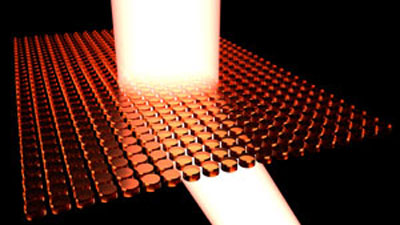| Posted: Jan 20, 2016 |
A simple artificial material can influence the properties of visible light
(Nanowerk News) Artificially engineered materials called metamaterials can be used to manipulate light for a range of applications, but often require complicated three-dimensional structures with features as small as a few tens of nanometers. Now, A*STAR researchers have constructed a simpler, two-dimensional ‘metasurface’ for state-of-the-art high-transmission light manipulation ("High-transmission dielectric metasurface with 2 phase control at visible wavelengths").
|
 |
| Visualization of the metasurface — a square array of silicon cylinders — manipulating the phase of visible light. (Image: A*STAR Data Storage Institute)
|
|
A metamaterial is a periodic array of subwavelength-sized elements that interact with an electromagnetic wave’s electric or magnetic component, or both. Each element can be engineered to create a material with optical properties beyond those found in naturally occurring substances. Metasurfaces harness the same idea but are only two-dimensional, and so easier to create.
|
|
Yefeng Yu and his co-workers from A*STAR’s Data Storage Institute have created a metasurface that can alter a property of light known as phase (see image). Light can be thought of as a wave with successive peaks and troughs. Moving this wave, to delay or hasten the peaks and troughs, is known as a phase shift. The metasurface designed and created by Yu and the team is capable of complete control over the phase of visible light. By creating certain phase shift distributions it is possible to focus light or even create on-demand holographic images.
|
|
The team’s metasurface comprised a square array of silicon disks. Each was 130 nanometers tall with a center-to-center separation of 360 nanometers. Light striking the surface of the structure passed through to the other side, but was deflected by approximately ten degrees. The phase change imparted to the transmitted light by the metasurface was dependent on the radius of the silicon disks. The team showed that varying the radii between 120 and 155 nanometers could produce any desired phase shift.
|
|
The main drawback of previous approaches to such optical components has been the low fraction of light transmitted. The structure created by the team reached a peak transmission of almost 90 per cent. “Most previous approaches are based on plasmonic nanoparticles, which have strong losses in the visible spectrum and typically have only an electric resonant response,” explains Yu. “The silicon particles we use can have both electric and magnetic resonances.” The researchers have nearly eliminated both losses and optical reflection from their metasurface.
|
|
“To make metasurfaces interesting for practical applications it is important to tune them and dynamically control the phase of incoming light,” says Yu. “This is something our group is now working on.”
|

